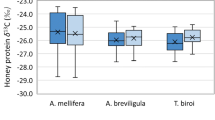Abstract
In the current study, we have comprehensively analyzed different kinds of pure honey which was produced in various areas in China according to δ13C-EA -IRMS (AOAC method 998.12) and δ13C-LC-IRMS (proposed by the Intertek laboratory in Europe) methods. As for the δ13C-EA -IRMS method, the study was confirmed that the C4 sugar of all authentic honey samples was qualified. Further inter-laboratory comparison experiments using the δ13C-LC-IRMS method found that all authentic honey samples had Δδ13C (‰) values within the naturally occurring range of ± 1‰ for Δδ13C (‰) fru-glu. However, about 70% samples had Δδ13C (‰) values outside the range of ± 2.1‰ for Δδ13C (‰) max., indicating that a large proportion of pure honey in China can’t pass the δ13C-LC-IRMS test, although these honeys were extracted from unadulterated sources. Based on the present findings, we consider that the δ13C-LC-IRMS method is not appropriate to reliably detect adulterated honeys with C3 sugars in China.


Similar content being viewed by others
References
AOAC (2000) Official methods of analysis. AOAC International, Gaithersburg, MD
Bertelli D, Lolli M, Papotti G, Bortolotti L, Serra G, Plessi M (2010) Detection of honey adulteration by sugar syrups using one-dimensional and two-dimensional high-resolution nuclear magnetic resonance. J Agric Food Chem 58:8495–8501. https://doi.org/10.1021/jf101460t
Cabanero AI, Recio JL, Ruperez M (2006) Liquid chromatography coupled to isotope ratio mass spectrometry: a new perspective on honey adulteration detection. J Agric Food Chem 54:9719–9727. https://doi.org/10.1021/jf062067x
Carbohydrates and the sweetness of honey (2010) National Honey Board, 303, 776–2337, 1–4. www.nhb.org
Cordella C, Militao JSLT, Climent MC, Drajnudel P, Carbol-Bass D (2005) Detection and quantification of honey adulteration via direct incorporation of sugar syrups or bee-feeding: preliminary study using high-performance anion exchange chromatography with pulsed amperometric detection (HPAEC-PAD) and chemometrics. Anal Chim Acta 531:239–248. https://doi.org/10.1016/j.aca.2004.10.018
Du B, Wu LM, Xue XF, Chen LZ, Li Y, Zhao J, Cao W (2015) Rapid screening of multiclass syrup adulterants in honey by ultrahigh-performance liquid chromatography/quadrupole time of flight mass spectrometry. J Agric Food Chem 63:6614–6623. https://doi.org/10.1021/acs.jafc.5b01410
Elflein L, Raezke KP (2008) Improved detection of honey adulteration by measuring differences between 13C/12C stable carbon isotope ratios of protein and sugar compounds with a combination of elemental analyzer—isotope ratio mass spectrometry and liquid chromatography—isotope ratio mass spectrometry (δ13C-EA/LC-IRMS). Apidologie 39:574–587. https://doi.org/10.1051/apido:2008042
Földahzi G (1994) Analysis and quantification of sugars in honey of different botanical origin using high performance liquid chromatography. Acta Aliment 23:299–311
Karabagias IK, Casiello G, Kontakos S, Louppis AP, Longobardi F, Kontominas MG (2016) Investigating the impact of botanical origin and harvesting period on carbon stable isotope ratio values (13C/12C) and different parameter analysis of Greek unifloral honeys: a chemometric approach for correct botanical discrimination. Int J Food Sci Technol 51:2460–2467. https://doi.org/10.1111/ijfs.13227
Kelly JD, Petisco C, Downey G (2006) Application of Fourier transform midinfrared spectroscopy to the discrimination between Irish artisanal honey and such honey adulterated with various sugar syrups. J Agric Food Chem 54:6166–6171. https://doi.org/10.1021/jf0613785
National Standard of the People’s Republic of China (2002) Method for the determination of high fructose starch syrup in honey-thin layer chromatographic method. GB/T 18932.2-2002
Oroian M, Ropciuc S, Paduret S (2018) Honey adulteration detection using raman spectroscopy. Food Anal Methods 11:959–968. https://doi.org/10.1007/s12161-017-1072-2
Padovan GJ, De Jong D, Rodrigues LP, Marchini JS (2003) Detection of adulteration of commercial honey samples by the 13C/12C isotopic ratio. Food Chem 82:633–636. https://doi.org/10.1016/S0308-8146(02)00504-6
Padovan GJ, Rodrigues LP, Leme IA, Jong David D, Marchini JS (2007) Presence of C4 sugars in honey samples detected by the carbon isotope ratio measured by IRMS. Eurasian J Anal Chem 2:134–141
Pang GF, Fan CL, Cao YZ, Zhang JJ, Li XM, Li ZY, Jia GQ (2006) Study on distribution pattern of stable carbon isotope ratio of Chinese honeys by isotope ratio mass spectrometry. J Sci Food Agric 86:315–319. https://doi.org/10.1002/jsfa.2328
Ruiz-Matute AI, Soria AC, Martinez-Castro I, Sanz MLA (2007) A new methodology based on GC–MS to detect honey adulteration with commercial syrups. J Agric Food Chem 55:7264–7269. https://doi.org/10.1021/jf070559j
Ruiz-Matute AI, Weiss M, Sammataro D, Finley J, Sanz ML (2010) Carbohydrate composition of high fructose corn syrups (HFCS) used for bee feeding effect on honey composition. J Agric Food Chem 58:7317–7322. https://doi.org/10.1021/jf100758x
Simsek A, Bilsel M, Goren AC (2012) 13C/12C pattern of honey from Turkey and determination of adulteration in commercially available honey samples using EA-IRMS. Food Chem 130:1115–1121. https://doi.org/10.1016/j.foodchem.2011.08.017
Wang JP, Guo J, Chen Y, Wang HY, Li R, Wang YL (2011) Assay of beta- fructofuranosidase activity in honey by high performance liquid chromatography. J Bee 12:21–23
Xu JZ, Liu XH, Wang YJ, Wang ZC, Zhou PP, Liu HD (2013) A method to fast detect the marker in beet syrup adulterated in honey. ZL 2013107003474.8
Xue XF, Wang Q, Li Y, Wu LM, Chen LZ, Zhao J, Liu FM (2013) 2-Acetylfuran-3-glucopyranoside as a novel marker for the detection of honey adulterated with rice syrup. J Agric Food Chem 61:7488–7493. https://doi.org/10.1021/jf401912u
Acknowledgements
This research project was supported by the by the Jiangxi provincial Natural Science Foundation for Youths of China (20161BAB213096).
Author information
Authors and Affiliations
Corresponding author
Ethics declarations
Conflict of interest
The author declares that they have no conflict of interest.
Additional information
Publisher's Note
Springer Nature remains neutral with regard to jurisdictional claims in published maps and institutional affiliations.
Rights and permissions
About this article
Cite this article
Xu, J., Liu, X., Wu, B. et al. A comprehensive analysis of 13C isotope ratios data of authentic honey types produced in China using the EA-IRMS and LC-IRMS. J Food Sci Technol 57, 1216–1232 (2020). https://doi.org/10.1007/s13197-019-04153-2
Revised:
Accepted:
Published:
Issue Date:
DOI: https://doi.org/10.1007/s13197-019-04153-2




